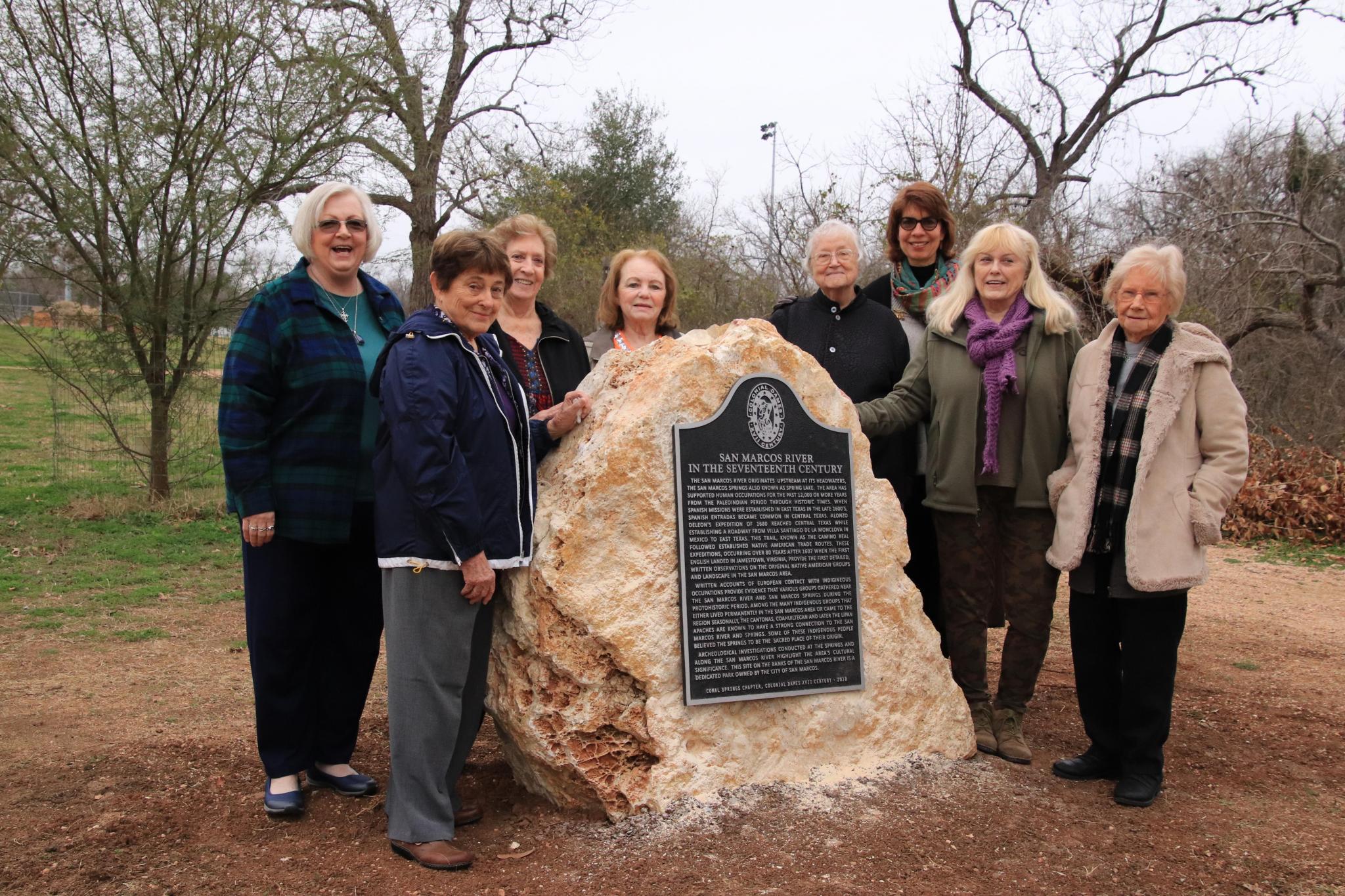
The new plaque donated by the Comal Chapter of the Colonial Dames of the XVII Century helps us understand the long history of humans on the San Marcos River. Pictured with the plaque are Colonial Dames Kay Bakken, Joan Jernigan, Betty Hebert, Joyce Rodgers, Muriel Jackson, Marcia Schmidt, Marilyn Beasley and Evelyn Reininger. Photo by Jerry Touchstone Kimmel
Life-long, life-wide, and life-deep learning on the San Marcos River
Would you like to spend time in one of the most beautiful places on Earth, developing an interest that can engage you for years — for free? You can. It’s the practice of using our river as your personal academy.
Are you thinking this sounds like school? It’s not school. It’s self-directed learning. Find something that interests you and seek knowledge about it. No tests, no grades, just the joy of learning.
What can you learn from the San Marcos River and why? You can learn the obvious things about nature and the less obvious things about ourselves and our history. The benefit is that knowledge about our world enriches our lives and gives us pleasure. You can develop interests that will last throughout your life and help you understand other places you visit.
The new plaque donated by the Comal Springs Chapter, Colonial Dames XVII Century, located on the banks of the river in Ramon Lucio Park, outlines the Spanish and Native American history along the river. The new plaque and other signs along the river help us learn its stories.
There are other good ways to read the river’s stories. For example, the magnificent bald cypress trees on its bank can help us understand how the river “works.”
You might wonder why floods haven’t knocked the trees down. How can such large trees live on the banks of a river that naturally had powerful floods? But when you look at a bald cypress you see its roots have formed an “armor” that protects the bank from erosion and helps the tree resist floods.
Then you learn that floods uproot cypress trees on the Blanco and other rivers, but that doesn’t seem to happen here. As you dig deeper into it, you find that after the destructive floods in the 1970s dams were built on the main tributaries of this part of the San Marcos River to reduce the power of floods. You also learn that flooding is a natural and essential river process which those dams significantly changed.
My point here is to demonstrate how an interest in one part of the river can lead to knowledge and understanding about our world. So what?
How can you do this? Very simply. Just go to the river and look. You’re bound to see something that catches your eye. When you do, look at it for a while. Form a detailed picture of it in you mind. Pay attention to what is around it and what all those things are doing. Make up a story about this in your mind or write it in a notebook. Then search the internet and look in reference books to see what you can find about the thing that caught your attention. You’ll find more than you can imagine!
When we think about what the San Marcos River is and how it “works” we begin to understand why it is such a great place for learning. It’s much more than just the little river you see running through town. It is the 1,250 square miles of the Edwards Aquifer that supplies the spring flow. It is the watershed lands of the Blanco River, Sink Creek, Purgatory Creek, and those of its tributaries downstream. It is the torrential storms that can cause disastrous floods and the droughts that can almost eliminate spring flow. It is all the plant and animal life of the river, including seven endangered and one threatened species. It is the people who have lived along its banks for many thousands of years, and the people today who seek fun, excitement, beauty, and knowledge from the river.
The San Marcos River is also an important part of our coastal ecosystems. It joins the Guadalupe River just upstream of Gonzales. The fresh water ultimately flows into San Antonio Bay and then Aransas Bay where it is essential for the highly productive habitats of those estuaries, where fresh and salt water mix to form nursery habitats. When you eat crab, oysters, or flounder at your favorite place on those bays, remember they are there with the help of the San Marcos River. For me, at least, knowing that puts my little river in a different and grand perspective.
Jim Kimmel and Jerry Touchstone Kimmel are the author and photographer of the book The San Marcos: A River’s Story.











